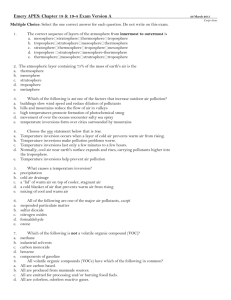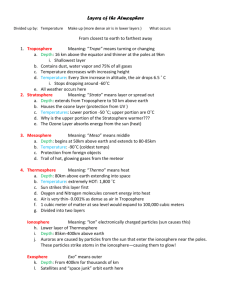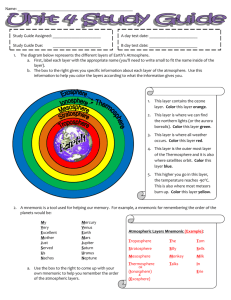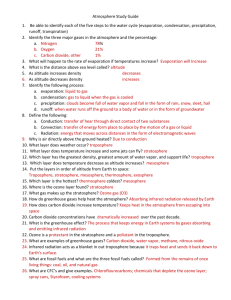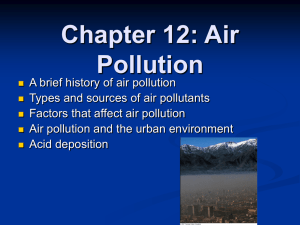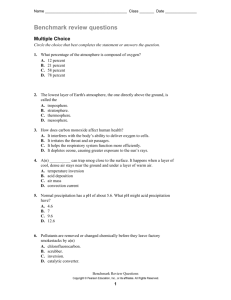Emery APES: Chapter 18 & 19-4 Exam Version B 26 March 2015
advertisement
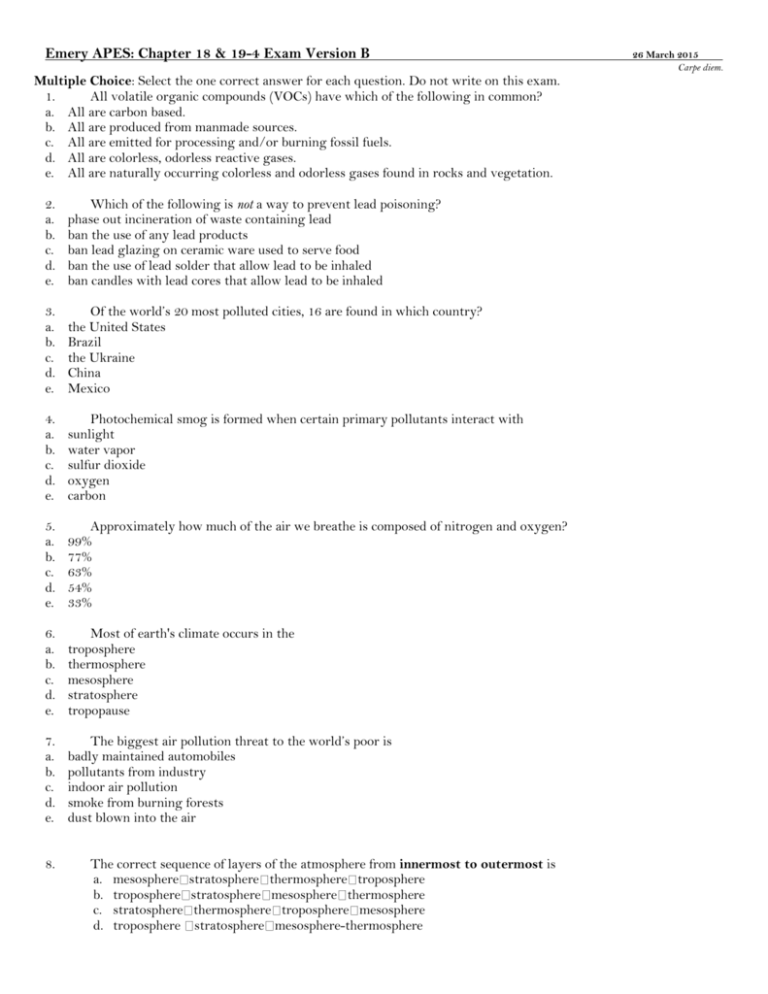
Emery APES: Chapter 18 & 19-4 Exam Version B Multiple Choice: Select the one correct answer for each question. Do not write on this exam. 1. All volatile organic compounds (VOCs) have which of the following in common? a. All are carbon based. b. All are produced from manmade sources. c. All are emitted for processing and/or burning fossil fuels. d. All are colorless, odorless reactive gases. e. All are naturally occurring colorless and odorless gases found in rocks and vegetation. 2. a. b. c. d. e. Which of the following is not a way to prevent lead poisoning? phase out incineration of waste containing lead ban the use of any lead products ban lead glazing on ceramic ware used to serve food ban the use of lead solder that allow lead to be inhaled ban candles with lead cores that allow lead to be inhaled 3. a. b. c. d. e. Of the world’s 20 most polluted cities, 16 are found in which country? the United States Brazil the Ukraine China Mexico 4. a. b. c. d. e. Photochemical smog is formed when certain primary pollutants interact with sunlight water vapor sulfur dioxide oxygen carbon 5. a. b. c. d. e. Approximately how much of the air we breathe is composed of nitrogen and oxygen? 99% 77% 63% 54% 33% 6. a. b. c. d. e. Most of earth's climate occurs in the troposphere thermosphere mesosphere stratosphere tropopause 7. a. b. c. d. e. The biggest air pollution threat to the world’s poor is badly maintained automobiles pollutants from industry indoor air pollution smoke from burning forests dust blown into the air 8. The correct sequence of layers of the atmosphere from innermost to outermost is a. mesosphere stratosphere thermosphere troposphere b. troposphere stratosphere mesosphere thermosphere c. stratosphere thermosphere troposphere mesosphere d. troposphere stratosphere mesosphere-thermosphere 26 March 2015 Carpe diem. e. thermosphere mesosphere stratosphere troposphere 9. a. b. c. d. e. 10. a. b. c. d. e. The atmospheric layer containing 75% of the mass of earth's air is the thermosphere mesosphere stratosphere troposphere metasphere Which of the following is not one of the factors that increase outdoor air pollution? buildings slow wind speed and reduce dilution of pollutants hills and mountains reduce the flow of air in valleys high temperatures promote formation of photochemical smog movement of over the oceans encounter salty sea spray temperature inversions form over cities surrounded by mountains 11. a. b. c. d. Choose the one statement below that is true. Temperature inversion occurs when a layer of cold air prevents warm air from rising. Temperature inversions make pollution problems worse. Temperature inversions last only a few minutes to a few hours. Normally, cool air near earth's surface expands and rises, carrying pollutants higher into the troposphere. e. Temperature inversions help prevent air pollution 12. a. b. c. d. e. What causes a temperature inversion? precipitation cold air drainage a “lid” of warm air on top of cooler, stagnant air a cold blanket of air that prevents warm air from rising mixing of cool and warm air 13. a. b. c. d. e. All of the following are one of the major air pollutants, except suspended particulate matter sulfur dioxide nitrogen oxides formaldehyde ozone 14. a. b. c. d. e. Which of the following is not a volatile organic compound (VOC)? methane industrial solvents carbon monoxide benzene components of gasoline 15. a. b. c. d. e. Large diesel trucks emit the equivalent amount of particulate matter as how many cars? 1 10 20 150 2000 16. During the 1980 and 2008 period, decreases in emissions occurred for all of the following pollutants, except a. lead b. CO2 c. SO2 d. CO e. ground-level ozone 17. According to environmental scientists, all of the following would strengthen U.S. air pollution control laws, except a. greater emphasis on prevent air pollution b. sharply reduce emissions from older coal-burning power plants c. relaxed controls on petroleum refineries d. improve fuel efficiency standards on motor vehicles e. stricter air pollution regulations on airports and ocean going ships 18. a. b. c. d. e. Most of the ozone layer is found in which of the following? thermosphere mesosphere thermopause stratosphere troposphere 19. a. b. c. d. e. Harmful chemicals emitted directly into the air from natural processes and human activities are called secondary pollutants smog photochemical smog tertiary pollutants primary pollutants 20. a. b. c. d. e. Most human input of outdoor air pollutants occur… in rural areas in the mountains along the oceans in urban areas in the deserts 21. a. b. c. d. e. Air pollution in the urban areas of many less-developed countries is getting much better remaining about the same getting a little better getting worse at crisis levels 22. a. b. c. d. e. Photochemical smog is characteristic of urban areas with many vehicles and a climate that is cool, wet, and cloudy cool, dry, and sunny warm, dry, and sunny warm, wet, and cloudy warm, wet, and sunny 23. a. b. c. d. e. All of the following are primary pollutants produced from burning coal, except carbon monoxide sulfur dioxide soot ozone carbon dioxide 24. Gray-air smog comes from suspended particles of a. carbon dioxide b. c. d. e. ammonium salts soot carbonic acid ozone 25. a. b. c. d. e. Which of the following would not be a factor that reduces outdoor air pollution? Particles that are heavier than air settle out of the atmosphere. Rain and snow wash pollutants out of the atmosphere. Winds sweep pollutants away. Chemical reactions form acid precipitation which falls out of the atmosphere Radiation from the sun converts pollutants into benign (harmless) chemicals. 26. a. b. c. d. e. How many times more acidic is precipitation in the eastern U.S. compared to natural precipitation? 2 times 4 times 6 times 8 times 10 times 27. a. b. c. d. e. Acid deposition is best classified as a(n) local problem state problem regional problem national problem international problem 28. a. b. c. d. e. 3.6 4.6 5.6 6.6 7.6 29. a. b. c. d. e. All of the following are effective preventive measures for acid deposition, except: reduce coal use burn low-sulfur coal switch to natural gas or renewable energy resources adding lime to neutralize the acids remove SO2 and NOx from motor vehicle exhausts 30. a. b. c. d. e. Sick Building Syndrome is associated with all of the following, except headaches coughing and sneezing lung cancer chronic fatigue depression 31. a. b. c. d. e. The air pollutant that causes the most problems for people in developed countries is: chloroform formaldehyde carbon monoxide asbestos sulfur dioxide Acidic rain (as well as acidic snow, fog, and cloud vapor) usually has a pH of about: 32. a. b. c. d. e. Respiratory illnesses in developing countries are most likely to be caused by formaldehyde cigarette smoke particulate matter asbestos chloroform 33. a. b. c. d. e. A layer of ozone reduces the sun's harmful UV radiation by how much? 95% 63% 49% 33% 20% 34. a. b. c. d. e. Which of the following chemicals is not capable of destroying ozone? chlorofluorocarbons formaldehyde used as a preservative halons in fire extinguishers and crop fumigants carbon tetrachloride used as a solvent methyl bromide used as a fumigant 35. If all of the ozone-depleting substances were banned tomorrow, how many years would it take for the earth to recover to pre-1950 ozone levels? a. 25 b. 50 c. 75 d. 100 e. 125 Congratulations! You have finished Chapter 18: Air Pollution. Please turn in your exam on lab station 7. Did you write “Version B” on your answer sheet?
